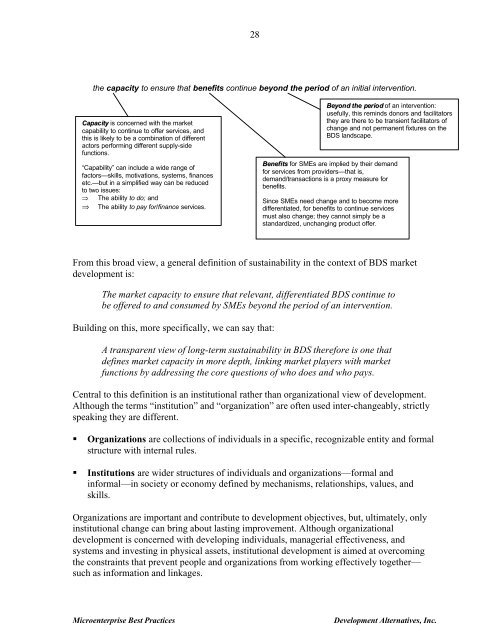BDS market development guide.pdf - PACA
BDS market development guide.pdf - PACA
BDS market development guide.pdf - PACA
You also want an ePaper? Increase the reach of your titles
YUMPU automatically turns print PDFs into web optimized ePapers that Google loves.
28<br />
the capacity to ensure that benefits continue beyond the period of an initial intervention.<br />
Capacity is concerned with the <strong>market</strong><br />
capability to continue to offer services, and<br />
this is likely to be a combination of different<br />
actors performing different supply-side<br />
functions.<br />
“Capability” can include a wide range of<br />
factors—skills, motivations, systems, finances<br />
etc.—but in a simplified way can be reduced<br />
to two issues:<br />
⇒ The ability to do; and<br />
⇒ The ability to pay for/finance services.<br />
Beyond the period of an intervention:<br />
usefully, this reminds donors and facilitators<br />
they are there to be transient facilitators of<br />
change and not permanent fixtures on the<br />
<strong>BDS</strong> landscape.<br />
Benefits for SMEs are implied by their demand<br />
for services from providers—that is,<br />
demand/transactions is a proxy measure for<br />
benefits.<br />
Since SMEs need change and to become more<br />
differentiated, for benefits to continue services<br />
must also change; they cannot simply be a<br />
standardized, unchanging product offer.<br />
From this broad view, a general definition of sustainability in the context of <strong>BDS</strong> <strong>market</strong><br />
<strong>development</strong> is:<br />
The <strong>market</strong> capacity to ensure that relevant, differentiated <strong>BDS</strong> continue to<br />
be offered to and consumed by SMEs beyond the period of an intervention.<br />
Building on this, more specifically, we can say that:<br />
A transparent view of long-term sustainability in <strong>BDS</strong> therefore is one that<br />
defines <strong>market</strong> capacity in more depth, linking <strong>market</strong> players with <strong>market</strong><br />
functions by addressing the core questions of who does and who pays.<br />
Central to this definition is an institutional rather than organizational view of <strong>development</strong>.<br />
Although the terms “institution” and “organization” are often used inter-changeably, strictly<br />
speaking they are different.<br />
• Organizations are collections of individuals in a specific, recognizable entity and formal<br />
structure with internal rules.<br />
• Institutions are wider structures of individuals and organizations—formal and<br />
informal—in society or economy defined by mechanisms, relationships, values, and<br />
skills.<br />
Organizations are important and contribute to <strong>development</strong> objectives, but, ultimately, only<br />
institutional change can bring about lasting improvement. Although organizational<br />
<strong>development</strong> is concerned with developing individuals, managerial effectiveness, and<br />
systems and investing in physical assets, institutional <strong>development</strong> is aimed at overcoming<br />
the constraints that prevent people and organizations from working effectively together—<br />
such as information and linkages.<br />
Microenterprise Best Practices<br />
Development Alternatives, Inc.














